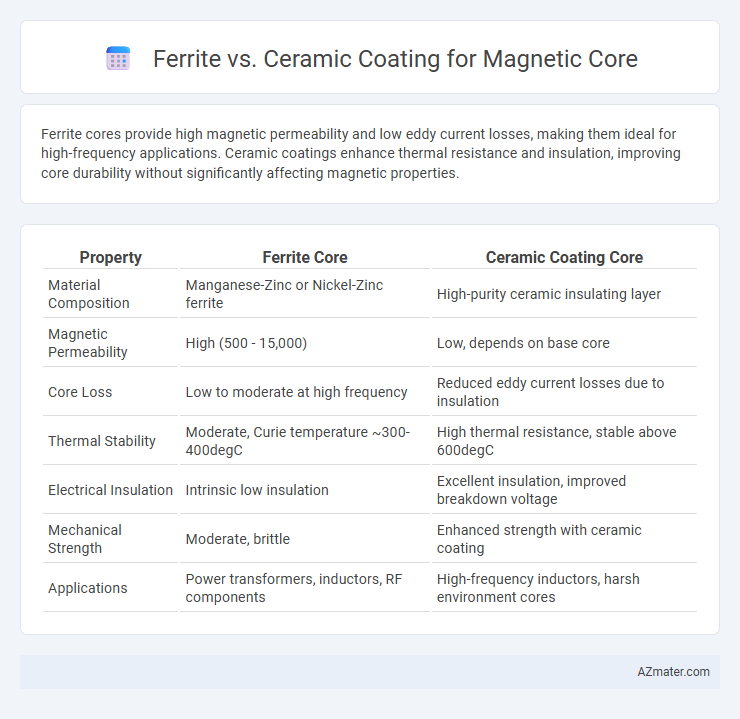Ferrite cores provide high magnetic permeability and low eddy current losses, making them ideal for high-frequency applications. Ceramic coatings enhance thermal resistance and insulation, improving core durability without significantly affecting magnetic properties.
Table of Comparison
| Property | Ferrite Core | Ceramic Coating Core |
|---|---|---|
| Material Composition | Manganese-Zinc or Nickel-Zinc ferrite | High-purity ceramic insulating layer |
| Magnetic Permeability | High (500 - 15,000) | Low, depends on base core |
| Core Loss | Low to moderate at high frequency | Reduced eddy current losses due to insulation |
| Thermal Stability | Moderate, Curie temperature ~300-400degC | High thermal resistance, stable above 600degC |
| Electrical Insulation | Intrinsic low insulation | Excellent insulation, improved breakdown voltage |
| Mechanical Strength | Moderate, brittle | Enhanced strength with ceramic coating |
| Applications | Power transformers, inductors, RF components | High-frequency inductors, harsh environment cores |
Introduction to Magnetic Core Materials
Ferrite magnetic cores, composed of iron oxide combined with metallic elements like zinc, nickel, or manganese, exhibit high magnetic permeability and low eddy current losses, making them ideal for high-frequency applications. Ceramic coatings on magnetic cores provide electrical insulation and thermal protection, enhancing core performance by reducing hysteresis losses and preventing short circuits in multilayer winding structures. Selecting between ferrite cores and ceramic-coated cores depends on factors such as operating frequency, thermal stability, and electromagnetic interference requirements in electronic devices.
Overview of Ferrite Coatings
Ferrite coatings consist of magnetic oxide compounds primarily composed of iron oxide mixed with other metal oxides like manganese, zinc, or nickel, offering high permeability and low electrical conductivity. These coatings provide excellent electromagnetic interference (EMI) suppression and are widely used in inductors, transformers, and antennas to improve signal integrity and reduce eddy current losses. Their compatibility with high-frequency applications and thermal stability make ferrite coatings a preferred choice over ceramic coatings in many magnetic core designs.
Overview of Ceramic Coatings
Ceramic coatings on magnetic cores provide enhanced thermal stability and electrical insulation, making them ideal for high-frequency applications where ferrite cores may suffer from eddy current losses. These coatings improve the mechanical durability and resistance to corrosion, extending the core's lifespan in harsh environments. Unlike ferrite cores, ceramic coatings maintain consistent magnetic properties across a wider temperature range, optimizing performance in industrial and automotive sectors.
Material Composition and Structure Comparison
Ferrite cores are composed primarily of iron oxide combined with other metal oxides such as manganese, zinc, or nickel, forming a crystalline ceramic structure that offers high magnetic permeability and low electrical conductivity. Ceramic cores, often based on non-magnetic materials like alumina or silicon nitride, provide excellent insulation and thermal stability but lack the magnetic properties integral to inductive applications. The ferrite's fine-grain crystalline arrangement facilitates efficient magnetic flux conduction, whereas ceramic cores emphasize durability and insulation rather than magnetic performance.
Magnetic Performance: Ferrite vs Ceramic
Ferrite cores exhibit higher magnetic permeability and lower core losses compared to ceramic cores, making them ideal for high-frequency applications. Ceramic cores, typically made from non-magnetic materials like aluminum oxide, have negligible magnetic properties, resulting in minimal magnetic performance. Ferrite's superior magnetic saturation and low eddy current losses significantly enhance efficiency and signal integrity over ceramic alternatives.
Electrical Insulation Properties
Ferrite magnetic cores exhibit excellent electrical insulation due to their high resistivity, minimizing eddy current losses in high-frequency applications. Ceramic coatings provide an additional insulating layer that enhances thermal stability and mechanical protection without compromising the core's magnetic properties. Optimizing the combination of ferrite cores with ceramic coatings improves overall electrical insulation, crucial for efficient transformer and inductor performance.
Durability and Thermal Stability
Ferrite magnetic cores exhibit enhanced durability due to their robust crystalline structure, which resists mechanical stress and decreases the risk of fracturing during operation. Ceramic coatings provide superior thermal stability by withstanding high temperatures without degradation, ensuring consistent magnetic performance under thermal stress. While ferrite cores inherently resist thermal fluctuations, ceramic coatings further extend operational lifespan by protecting the core from oxidation and thermal fatigue.
Cost and Manufacturing Considerations
Ferrite coatings for magnetic cores typically offer lower material costs and simpler manufacturing processes compared to ceramic coatings, which often require higher-temperature sintering and more precise fabrication techniques. Ceramic coatings provide superior thermal stability and electrical insulation but increase overall production expenses due to longer processing times and specialized equipment. Cost efficiency in ferrite coatings makes them preferable for mass-produced applications, while ceramic coatings suit high-performance cores where durability and electrical insulation justify the higher investment.
Application Suitability and Industry Use
Ferrite cores offer high magnetic permeability and low eddy current losses, making them ideal for high-frequency transformers, inductors, and EMI suppression in telecommunications and consumer electronics. Ceramic coatings provide excellent thermal stability and electrical insulation, suitable for high-temperature applications and automotive or aerospace industries requiring robust protection against corrosion and mechanical wear. Choosing between ferrite and ceramic coatings depends on specific application needs, balancing magnetic performance with environmental durability across power electronics and industrial equipment sectors.
Summary: Choosing Between Ferrite and Ceramic Coatings
Ferrite coatings provide excellent magnetic permeability and high-frequency performance, making them ideal for transformers and inductors in RF applications. Ceramic coatings offer superior thermal stability, mechanical strength, and insulating properties, suitable for harsh environments and high-temperature operations. Selecting between ferrite and ceramic coatings depends on the specific magnetic performance requirements and environmental conditions of the application.

Infographic: Ferrite vs Ceramic coating for Magnetic core
 azmater.com
azmater.com